Understanding How to Increase Your Deadlift Max
In this article, we’ll reveal essential strategies on how to increase your deadlift max, from perfecting your form to optimizing recovery for stronger lifts.
The deadlift stands as one of the most revered and effective exercises in the world of strength training. It’s celebrated for its ability to build substantial muscle mass, enhance overall strength, and improve functional fitness. Unlike many other exercises that isolate specific muscle groups, the deadlift is a compound movement that engages multiple muscle groups simultaneously. This makes it a cornerstone exercise for anyone serious about strength training.
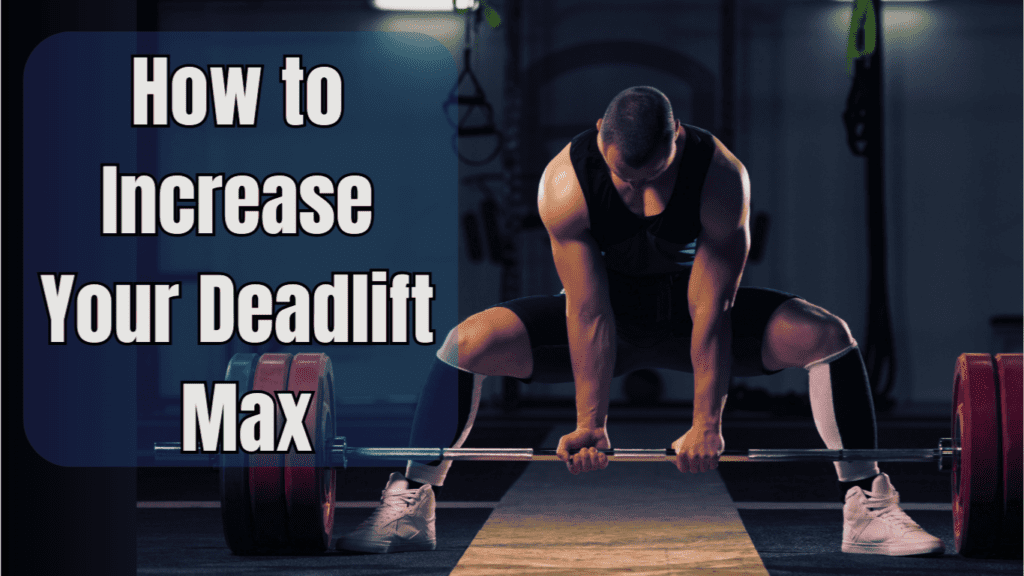
Why is the deadlift so important? The key lies in its engagement of the posterior chain—a group of muscles that includes the glutes, hamstrings, and lower back. These muscles are crucial not only for athletic performance but also for day-to-day activities. When you perform a deadlift, you’re training these muscles to work together efficiently, which translates to better performance in sports and improved functionality in everyday life. This comprehensive engagement is why the deadlift is often referred to as a full-body exercise.
The glutes are perhaps the most notable muscle group involved in the deadlift. They play a critical role in hip extension, which is essential for completing the lift. Strong glutes contribute to powerful hip drives, helping you lift heavier weights and maintain stability throughout the movement. Without adequate glute strength, you may struggle to generate the power needed for a successful lift, which can limit your overall deadlift max.
The hamstrings also play a significant role in the deadlift. Located at the back of your thighs, the hamstrings assist in both knee flexion and hip extension. During the deadlift, they help to extend the hips and straighten the knees as you lift the barbell from the ground. Weak hamstrings can impair your lifting technique and limit the amount of weight you can handle, making it difficult to achieve a higher deadlift max.
The lower back, or lumbar region, provides crucial support throughout the lift. A strong lower back helps you maintain proper posture and alignment, reducing the risk of injury. If your lower back is not adequately conditioned, you may experience discomfort or pain during and after the lift, which can hinder your progress and limit your ability to lift heavier weights.
Subscribe And Get Our Free E-Book:Unlocking The Power Of Nutrition-Supplements, Substitutes, and Superfoods!
Despite its benefits, many lifters encounter common issues with deadlifting. One frequent challenge is hitting a plateau, where progress seems to stall despite continued effort and training. This can be particularly frustrating, as it may feel like you’re putting in the work but not seeing the desired results. Understanding how to increase your deadlift max involves identifying the factors contributing to these plateaus and addressing them effectively.
Another common issue is maintaining proper form during the deadlift. Correct form is essential for maximizing your lifting potential and preventing injury. Problems with form can arise from various factors, including inadequate flexibility, muscle imbalances, or a lack of understanding of the correct technique. Poor form not only limits your lifting capacity but can also lead to inefficiencies and potential harm. Learning how to increase your deadlift max requires a focus on perfecting your technique and making necessary adjustments to ensure safety and effectiveness.
In this article, we will explore practical, science-backed strategies to help you learn how to increase your deadlift max. We’ll cover a range of topics designed to address the common challenges associated with deadlifting, from overcoming plateaus to perfecting your form. By understanding and applying these strategies, you’ll be well-equipped to enhance your deadlift performance and achieve new personal bests.
Our approach will be grounded in proven methods and techniques, ensuring that you get actionable advice that you can integrate into your training routine. We’ll delve into exercises and practices that specifically target the posterior chain, strategies for progressive overload, and tips for improving recovery and addressing weaknesses. Each section will provide insights that are not only practical but also scientifically supported, helping you to make informed decisions about your training.
Whether you’re new to deadlifting or an experienced lifter looking to push past a plateau, understanding how to increase your deadlift max is essential for reaching your goals. With the right knowledge and approach, you can overcome obstacles, enhance your performance, and achieve a stronger, more powerful deadlift. Stay tuned as we guide you through the steps to transform your deadlift training and unlock your full potential.
Easy Tips To Increase Your Deadlift Video
Setting a Baseline: Assess Your Current Deadlift Max
To make meaningful progress in your deadlift, it’s essential to start by understanding where you currently stand. Knowing your current deadlift max is a critical first step in learning how to increase your deadlift max. This baseline measurement will serve as a reference point, allowing you to gauge improvements over time and tailor your training approach accordingly.
Finding Your One-Rep Max (1RM) Safely
To determine your one-rep max (1RM), you need to perform a test that measures the maximum weight you can lift for a single repetition. This test should be approached with care to ensure safety and accuracy. Here’s a step-by-step guide on how to find your 1RM:
Warm-Up Properly: Before attempting your max lift, it’s crucial to prepare your body with a thorough warm-up. Start with 5-10 minutes of light cardio to increase your heart rate and get your blood flowing. Follow this with dynamic stretching focusing on the muscles used in deadlifting—the glutes, hamstrings, and lower back. After this, perform several sets of lighter deadlifts to activate the muscles and practice your form.
Progress Gradually: Begin with a weight that is significantly lighter than your estimated max—about 50% of what you believe your 1RM might be. Perform 8-10 reps at this weight to get your muscles accustomed to the movement. Gradually increase the weight in small increments, such as 10-20 pounds, and perform 3-5 reps at each stage. This approach allows your body to adjust and reduces the risk of injury.
Test Your Max: Once you’re warmed up and have increased the weight incrementally, you can attempt your 1RM. Start with a weight that you believe you can lift for a single repetition but might be challenging. If successful, rest for a few minutes, then increase the weight slightly and try again. Continue this process until you find the maximum weight you can lift for one full rep with proper form.
Safety First: Ensure you have a spotter or use safety equipment like deadlift blocks or bumper plates when testing your max. Proper technique is crucial not only for performance but also for injury prevention.
How to Increase Your Deadlift Max: The Science Behind Baseline Strength
Understanding your baseline strength is vital in learning how to increase your deadlift max. Your 1RM provides a benchmark for assessing your progress and setting realistic goals. Tracking changes in your 1RM over time allows you to measure the effectiveness of your training regimen and make informed adjustments.
Baseline strength helps in designing a structured program tailored to your specific needs. For instance, if your current 1RM is relatively low, you may need to focus on foundational strength-building exercises. Conversely, if you’re close to your goal, fine-tuning your technique and increasing lifting volume might be more beneficial.
By regularly assessing your 1RM, you can also monitor improvements and ensure that your training is progressing as planned. This regular assessment helps in maintaining motivation and allows for adjustments in your workout routine based on real data rather than guesswork.

Key Tip of How to Increase Your Deadlift Max: Prioritize Form Before Maxing Out
A critical aspect of learning how to increase your deadlift max is ensuring that your form is correct before attempting to lift heavy weights. Proper form is not only essential for maximizing performance but also for preventing injuries. Poor technique can lead to unnecessary strain on your lower back, hamstrings, and glutes, potentially resulting in injuries that could set back your progress significantly.
Focus on Key Form Elements: Ensure that your back remains straight throughout the lift, and your core is engaged to support your spine. Your feet should be positioned hip-width apart, and your grip should be firm but not over-tightened. Practice maintaining these elements with lighter weights before progressing to heavier loads.
Perform Technique Drills: Incorporate specific drills into your routine that focus on improving deadlift form. For example, performing deadlift variations such as Romanian deadlifts or rack pulls can help you strengthen weak points and enhance your technique.
Seek Feedback: If possible, work with a coach or experienced lifter who can provide feedback on your form. Having a second set of eyes can help identify any issues you may not be aware of and offer guidance on how to correct them.
In summary, setting a baseline by assessing your current deadlift max is a crucial first step in learning how to increase your deadlift max. Properly finding your 1RM involves a safe and gradual approach, including a thorough warm-up and incremental weight increases. Understanding your baseline strength allows you to track progress and tailor your training effectively. Most importantly, prioritizing proper form before attempting to lift heavy weights is essential for both enhancing performance and preventing injuries. By following these guidelines, you’ll be well-equipped to safely and effectively increase your deadlift max.
How to Increase Your Deadlift Max: Form First- Master Your Technique
When it comes to learning how to increase your deadlift max, mastering proper technique is paramount. The deadlift is a complex lift that requires precise form to ensure effectiveness and prevent injury. By focusing on technique, you not only enhance your performance but also safeguard yourself from potential harm. Let’s break down the key elements of proper deadlift form and discuss how to avoid common errors, the differences between deadlift variations, and the science behind it all.
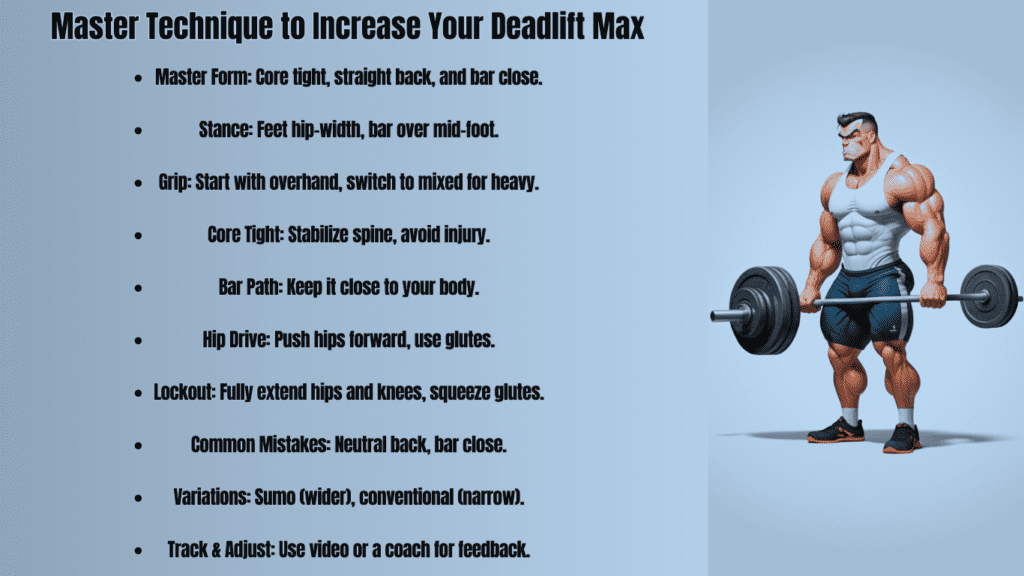
Practical Breakdown: Step-by-Step Guide on Perfect Deadlift Form
- Stance: Start by positioning your feet approximately hip-width apart. Your toes should point slightly outward. This stance allows for optimal alignment and balance. Ensure that the barbell is positioned over the middle of your feet, so it stays close to your body throughout the lift. This setup is crucial for maintaining balance and maximizing leverage.
- Grip: The grip on the barbell should be just outside your knees. You can choose between a double overhand grip or a mixed grip (one hand over, one hand under). A double overhand grip is generally recommended for maintaining balance and avoiding muscle imbalances. The mixed grip can be used as you lift heavier weights to prevent the bar from slipping. Ensure your grip is firm but not overly tight to avoid unnecessary strain.
- Back Positioning: As you prepare to lift, engage your core and keep your back straight. Your back should be in a neutral position, not rounded or excessively arched. Keeping your back straight helps distribute the load evenly across your posterior chain and reduces the risk of lower back injury. Imagine trying to keep your chest up and out as you initiate the lift.
- Bar Path: As you lift the barbell, it should travel in a straight line, close to your body. This bar path ensures that you’re utilizing the correct muscles and maintaining balance. Any deviation from this path can place additional stress on your back and reduce the effectiveness of the lift.
- Lockout: At the top of the lift, fully extend your hips and knees to complete the movement. Avoid overextending your lower back; instead, focus on squeezing your glutes and standing tall. Proper lockout is essential for completing the lift and ensuring that you’ve achieved full range of motion.
Common Errors of How to Increase Your Deadlift Max and How to Correct Them
Even experienced lifters can fall prey to common deadlift errors. Here’s how to identify and correct them:
- Rounded Back: One of the most common mistakes is rounding the lower back during the lift. This often happens when lifters are trying to lift too much weight or lack core strength. To correct this, focus on engaging your core muscles and maintaining a neutral spine throughout the lift. Practice with lighter weights to reinforce proper form before gradually increasing the load.
- Bar Path Deviation: If the barbell moves away from your body during the lift, it can place undue stress on your back and reduce lifting efficiency. Ensure that you’re keeping the bar close to your shins and thighs throughout the lift. Use mirrors or record yourself to check the bar path and make adjustments as needed.
- Hip Drive Issues: Improper hip drive can lead to incomplete lifts or lower back strain. To improve hip drive, focus on pushing your hips forward and engaging your glutes as you stand up with the barbell. Practice the hip extension movement separately to build strength and coordination.
Variations: Sumo vs. Conventional
Understanding the differences between sumo and conventional deadlifts can help you decide which variation is best suited for your goals and body mechanics.
- Sumo Deadlift: In the sumo deadlift, you adopt a wider stance with toes pointing outwards. This variation emphasizes the inner thighs and glutes more than the conventional deadlift. It can be beneficial if you have a limited range of motion or if you’re looking to target different muscle groups. The sumo deadlift often reduces strain on the lower back, making it a useful alternative for those with back issues.
- Conventional Deadlift: The conventional deadlift involves a narrower stance and focuses more on the posterior chain, including the hamstrings and lower back. It requires greater hip and lower back mobility and is generally considered the standard deadlift form. This variation is often preferred for building overall strength and power.
How to Increase Your Deadlift Max: Science Angle- The Biomechanics of the Deadlift
The biomechanics of the deadlift are integral to understanding how to increase your deadlift max. Proper form ensures that you’re activating the right muscles while minimizing the risk of injury. When executed correctly, the deadlift effectively targets the posterior chain, leveraging biomechanical principles to maximize force output and efficiency.
The posterior chain plays a critical role in the deadlift. By engaging the glutes, hamstrings, and lower back, the deadlift trains these muscles to work together in a coordinated manner. Proper form ensures that these muscles are activated throughout the lift, allowing for more effective and safer lifting.
Core Stabilization is also crucial for maintaining proper form during the deadlift. A strong core helps support the spine and maintain a neutral back position. Engaging your core throughout the lift helps distribute the load evenly and reduces the risk of injury. Incorporate core-strengthening exercises into your routine to enhance your stability and overall performance.
Key Tip: Use Video or Coaching for Form Assessment
To ensure that you’re performing the deadlift correctly, consider recording yourself or working with a coach to assess your form. Video analysis allows you to review your technique from different angles and identify any deviations from proper form. A coach can provide expert feedback and help you make necessary adjustments to improve your technique and prevent injuries.
In summary, mastering your deadlift technique is essential for learning how to increase your deadlift max. By focusing on proper form—stancing, gripping, back positioning, bar path, and lockout—you can enhance performance and reduce injury risk. Understanding common errors and incorporating deadlift variations can further optimize your training. With a solid grasp of the biomechanics involved and regular form assessments, you’ll be well on your way to achieving a higher deadlift max and improved strength overall.
Build a Strong Foundation: Accessory Exercises
When aiming to enhance your deadlift performance, focusing solely on the lift itself isn’t enough. To effectively learn how to increase your deadlift max, it’s crucial to incorporate accessory exercises that target the specific muscles involved in the deadlift. These exercises can help address weak points, improve overall strength, and correct muscle imbalances. Let’s dive into the practical aspects of accessory movements and understand their significance in your deadlift training.
Practical Advice: Accessory Movements to Strengthen Your Deadlift
- Romanian Deadlifts (RDLs): RDLs are an excellent accessory exercise for targeting the hamstrings, which play a crucial role in the deadlift. To perform an RDL, start with a barbell at hip level, keep your knees slightly bent, and lower the barbell by hinging at the hips while maintaining a straight back. This movement emphasizes the hamstrings and glutes, enhancing their strength and flexibility. Incorporating RDLs into your routine helps build the posterior chain, translating directly to a stronger deadlift.
- Barbell Rows: Barbell rows are essential for engaging the back muscles, particularly the lats. Strong lats contribute to better stability and control during the deadlift. To execute a barbell row, bend at the hips and knees, keeping your back flat. Pull the barbell towards your lower chest, squeezing your shoulder blades together at the top of the movement. This exercise strengthens the upper back and improves your ability to maintain proper posture during heavy deadlifts.
- Rack Pulls: Rack pulls are a variation of the deadlift that focuses on lockout strength—the ability to fully extend your hips and knees at the top of the lift. Set the barbell on a rack or blocks so that it starts at just below knee height. Perform the lift as you would a regular deadlift but from this elevated position. Rack pulls help develop the strength needed to complete the lift and can be particularly beneficial if you struggle with the lockout phase of the deadlift.
- Glute Bridges: Glute bridges are effective for enhancing hip thrust power, which is crucial for a strong deadlift. To perform a glute bridge, lie on your back with your knees bent and feet flat on the floor. Push through your heels and lift your hips towards the ceiling, squeezing your glutes at the top. This exercise strengthens the glutes and improves hip drive, contributing to a more powerful deadlift.
Science Angle: Hypertrophy and Muscle Imbalances
Understanding how hypertrophy (muscle growth) in key muscle groups translates to a stronger deadlift is crucial for learning how to increase your deadlift max. Hypertrophy refers to the increase in muscle size that results from strength training. In the context of deadlifting, hypertrophy in the glutes, hamstrings, and lats enhances your lifting capacity and performance.
- Glutes: Stronger glutes contribute to more effective hip extension during the deadlift. As you strengthen your glutes through exercises like glute bridges, you’ll find it easier to lock out the lift and maintain proper form.
- Hamstrings: Hypertrophy in the hamstrings improves their ability to assist in hip extension and stabilize the movement. Exercises like RDLs focus on this muscle group, leading to better overall deadlift performance.
- Lats: The lats are crucial for stabilizing the back and maintaining proper posture during the deadlift. Barbell rows and similar exercises help develop these muscles, contributing to better control and a more efficient lift.
Muscle Imbalances can often hinder deadlift performance and increase the risk of injury. Accessory exercises are designed to address these imbalances by strengthening weaker muscle groups and improving overall muscular coordination. For example, if your glutes are significantly weaker than your hamstrings, your deadlift form may suffer, and you may struggle with the lockout phase. By incorporating exercises that target the glutes and hamstrings, you can correct these imbalances and enhance your deadlift max.
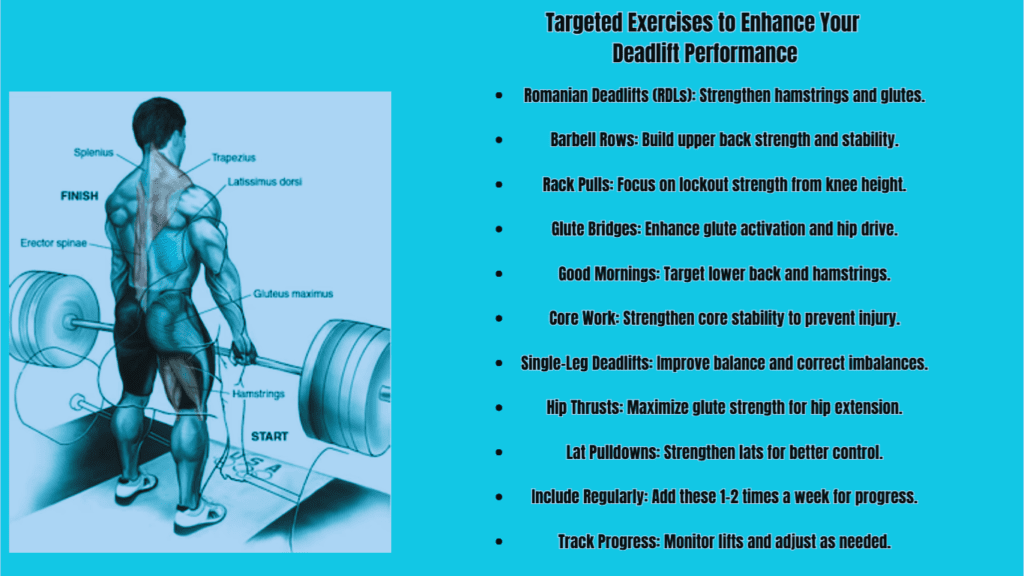
Key Tip: Integrate Accessory Exercises Regularly
To effectively improve your deadlift max, it’s important to build accessory exercises into your routine consistently. Aim to include these movements at least once or twice a week. Incorporating them into your workout plan ensures that you address weak points and imbalances, leading to better overall performance in your deadlift training.
Creating a Balanced Routine
When incorporating accessory exercises, ensure that your routine is well-balanced and complements your deadlift training. For instance, if you’re performing Romanian deadlifts and barbell rows, ensure that these exercises are spread out across different workout days to allow for adequate recovery. This balanced approach helps prevent overtraining and maximizes the benefits of each exercise.
How to Increase Your Deadlift Max: Tracking Progress
Regularly track your progress with accessory exercises to gauge their impact on your deadlift performance. Record the weights you’re lifting and note any improvements in your deadlift max. This data will help you assess the effectiveness of your accessory work and make necessary adjustments to your routine.
Adjusting as Needed
As you progress, be prepared to adjust your accessory exercises based on your evolving needs. If you notice that certain muscle groups are becoming stronger and others are still lagging, modify your routine to address these changes. This adaptive approach ensures that you continue to make progress and effectively learn how to increase your deadlift max.
In summary, building a strong foundation with accessory exercises is a key component in learning how to increase your deadlift max. Exercises like Romanian deadlifts, barbell rows, rack pulls, and glute bridges target weak points, address muscle imbalances, and contribute to overall strength development. Understanding the science behind hypertrophy and incorporating these exercises regularly into your routine will enhance your deadlift performance and help you achieve your strength goals.
Projected Deadlift Max Progression Over 12 Weeks Chart:
( This Chart Is Just An Example):
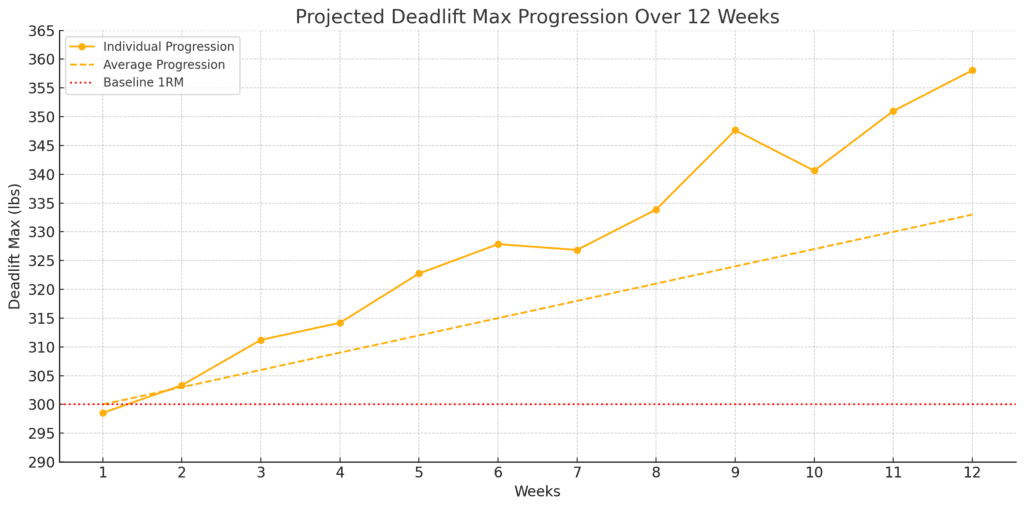
Here’s a chart that visually represents the projected progression of an individual’s deadlift max over 12 weeks, along with the baseline starting point and average improvements.
Chart Summary:
- Individual Progression: This line shows a hypothetical individual’s progress, with some variability to represent real-life fluctuations in training performance. The gradual increase suggests consistent effort and adaptation.
- Average Progression: This dashed line indicates a more stable average increase that a typical lifter might expect if they follow a structured training program.
- Baseline 1RM: The dotted line marks the starting point (in this case, 300 lbs), serving as a crucial reference for measuring progress.
Programming: How to Progress Safely and Effectively
To achieve success in increasing your deadlift max, having a structured and thoughtful approach to programming is essential. Learning how to increase your deadlift max involves more than just lifting heavier weights; it requires a strategic plan that includes progressive overload, appropriate recovery, and varied intensity. In this section, we’ll explore different programming methods, the science behind progressive overload, and the importance of recovery in your training regimen.
Practical Approach: Deadlift Programming Examples
- Linear Progression: Linear progression is a straightforward approach where you gradually increase the weight you lift each session. This method is particularly effective for beginners or those who have recently started focusing on increasing their deadlift max. Here’s a simple way to implement linear progression:
- Week 1: Perform 3 sets of 5 reps at a weight that feels moderately challenging.
- Week 2: Increase the weight by 5-10 pounds and maintain the same number of sets and reps.
- Week 3: Continue adding weight each week while keeping the volume consistent until you reach a plateau.
- Periodization: Periodization involves cycling through different phases of intensity and volume to optimize training and prevent burnout. This method helps in managing fatigue and reducing the risk of overtraining. A common approach is to divide your training into macrocycles, mesocycles, and microcycles:
- Macrocycle: This is the long-term training plan, often spanning several months to a year.
- Mesocycle: A medium-term phase lasting a few weeks to a couple of months, focusing on specific goals like strength or hypertrophy.
- Microcycle: Short-term phases, usually a week or two, focusing on weekly goals and recovery.
- The 5/3/1 Method and Texas Method: For advanced lifters, the 5/3/1 Method and the Texas Method offer structured approaches to progress safely and effectively.
- 5/3/1 Method: Developed by Jim Wendler, this method focuses on four main lifts, including the deadlift. It involves working with percentages of your one-rep max (1RM) and cycling through phases of 5, 3, and 1 rep sets. The emphasis is on gradually increasing the weight over several cycles, ensuring consistent progress.
- Texas Method: Created by Mark Rippetoe, the Texas Method includes a high-volume day, a recovery day, and an intensity day. This method is designed to maximize strength gains by incorporating heavy lifting, moderate volume, and ample recovery.
Science Angle: Progressive Overload and Nervous System Adaptation
Progressive Overload is a fundamental principle in strength training and is crucial for learning how to increase your deadlift max. Progressive overload involves gradually increasing the stress placed on your muscles to stimulate growth and strength. This can be achieved through various means, such as adding weight, increasing reps, or altering the training volume.
Nervous System Adaptation: As you progressively increase the weights you lift, your nervous system adapts to handle the greater load. Initially, the improvements in strength come from enhanced neuromuscular efficiency—your nervous system becomes better at recruiting muscle fibers and coordinating muscle contractions. Over time, as your muscles adapt to the increased stress, further gains are achieved through muscle hypertrophy and improved recovery.
Recovery Science: Importance of Rest and Deload Weeks
Recovery is a critical component of any effective deadlift program. Learning how to increase your deadlift max isn’t just about lifting heavier weights; it’s also about allowing your body adequate time to recover and adapt. Here’s why recovery and deload weeks are essential:
- Avoiding Injury: Overtraining without proper recovery increases the risk of injuries, including strains and overuse injuries. Deload weeks, where you reduce the volume and intensity of your training, give your body a chance to heal and recover from the accumulated stress.
- Ensuring Long-Term Progress: Regular recovery periods prevent burnout and ensure sustained progress. A typical deload week might involve lifting lighter weights or reducing the number of sets and reps. This approach allows your muscles and nervous system to recover, leading to improved performance when you return to regular training.
- Replenishing Energy Stores: Intense training depletes your body’s energy stores and increases the need for nutritional recovery. During recovery periods, focus on replenishing these stores through proper nutrition and hydration.
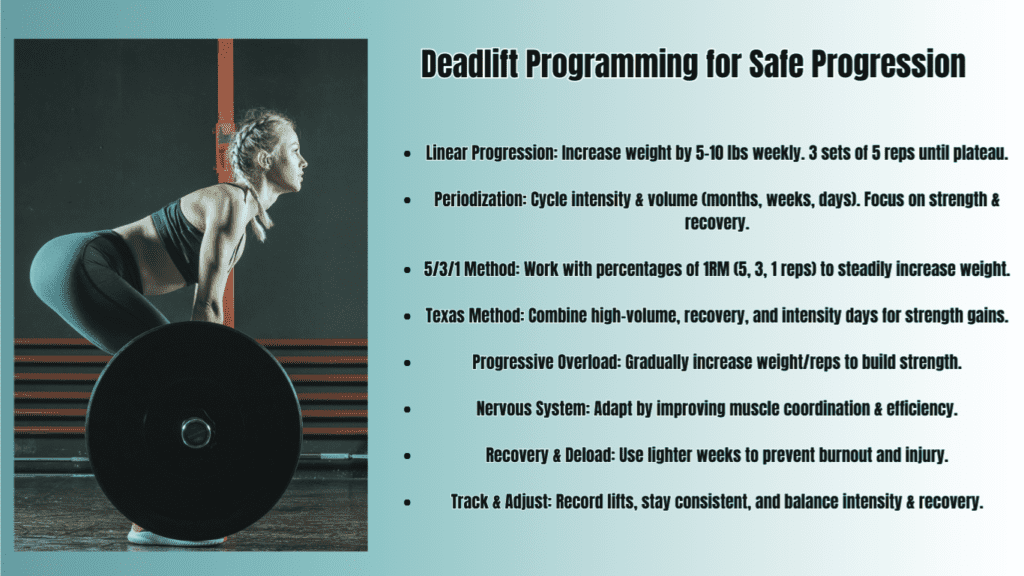
Key Tip: Track Your Lifts, Stay Consistent, and Know When to Push or Pull Back
Tracking your lifts is essential for effective programming. Regularly recording your performance helps you monitor progress, identify trends, and make informed adjustments to your training. Consistency in your routine is also crucial for achieving long-term gains.
However, it’s equally important to understand when to push hard and when to pull back. Pushing too hard without adequate recovery can lead to overtraining and injuries, while pulling back too often may stall your progress. Striking the right balance between intensity and recovery ensures continuous improvement and minimizes the risk of setbacks.
In summary, a well-structured programming approach is vital for learning how to increase your deadlift max effectively and safely. Linear progression, periodization, and advanced methods like the 5/3/1 and Texas Method offer various strategies for managing load and volume. Understanding progressive overload and the role of the nervous system in adaptation, along with the importance of recovery, ensures that your training remains effective over time. By tracking your lifts, staying consistent, and adjusting your intensity based on your needs, you’ll be well on your way to achieving a higher deadlift max and reaching your strength goals.
Overview of Deadlift Programming Methods Chart:
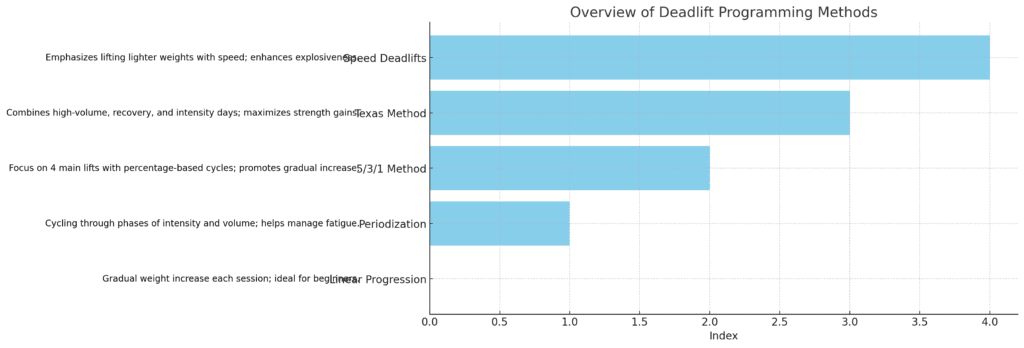
Here’s a chart that provides an overview of different deadlift programming methods based on the article. It outlines the programming methods, their descriptions, focuses, and ideal lifters, making it an informative complement to the article.
Overview of Deadlift Programming Methods
- Linear Progression: Gradual weight increase each session; ideal for beginners.
- Periodization: Cycling through phases of intensity and volume; helps manage fatigue.
- 5/3/1 Method: Focus on four main lifts with percentage-based cycles; promotes gradual increase.
- Texas Method: Combines high-volume, recovery, and intensity days; maximizes strength gains.
- Speed Deadlifts: Emphasizes lifting lighter weights with speed; enhances explosiveness.
How to Increase Your Deadlift Max with Speed Deadlifts
When aiming to boost your deadlift max, focusing on the speed of your lift can be just as crucial as the amount of weight you’re lifting. Learning how to increase your deadlift max involves not only increasing strength but also enhancing the power and explosiveness of your lift. This section will delve into the concept of speed deadlifts and their role in improving your overall performance.
Practical Advice: Introducing Speed Deadlifts
Speed deadlifts are a specialized form of deadlifting that emphasizes lifting lighter weights with maximum speed and explosiveness. The primary goal is to improve your ability to accelerate the barbell from the floor and through the entire range of motion. Here’s how you can incorporate speed deadlifts into your routine:
- Choose Lighter Weights: Select a weight that is approximately 50-70% of your one-rep max (1RM). The key is to use a load that is light enough to allow you to focus on speed rather than sheer strength. This lighter weight ensures that you can lift explosively without compromising form.
- Focus on Explosive Movement: As you lift the barbell, concentrate on accelerating it as quickly as possible from the floor. The speed at which you lift is critical; aim to complete each rep with maximum velocity. This explosive movement helps train your muscles and nervous system to generate power more efficiently.
- Maintain Proper Form: Despite using lighter weights, maintaining proper form is essential. Ensure your back remains flat, your core is engaged, and the bar follows a straight path. Proper technique helps reinforce good lifting habits and prevents injuries.
- Incorporate into Your Routine: Integrate speed deadlifts into your training program once or twice a week. They can be performed on a separate day from your heavy deadlifting sessions or as part of a dynamic effort day. Avoid overdoing them, as the primary focus should be on speed and explosiveness rather than volume.
Science Angle: The Role of Fast-Twitch Muscle Fibers
Understanding the science behind speed deadlifts provides insight into why this approach is effective for increasing your deadlift max. The primary science aspect here is the role of fast-twitch muscle fibers.
Fast-twitch muscle fibers are specialized for generating powerful and explosive movements. Unlike slow-twitch fibers, which are more endurance-oriented, fast-twitch fibers are designed to exert force quickly and efficiently. When you perform speed deadlifts, you train these fibers to work optimally, which translates to improved performance in heavier lifts.
Breaking Through Plateaus: If you’re struggling with a plateau in your deadlift progress, incorporating speed deadlifts can help. Speed work helps develop your explosive strength, which is crucial for overcoming sticking points. By increasing the speed of your lift, you improve your ability to accelerate through difficult phases of the lift, such as the initial pull-off the floor or the lockout.
The Concept of Bar Velocity: Speed deadlifts also enhance bar velocity, which is the rate at which the barbell moves during the lift. Improved bar velocity means you can move the bar more quickly, which is essential for lifting heavier weights. Training with speed deadlifts helps you develop the capacity to accelerate the barbell more effectively, contributing to overall strength gains.
Key Tip: Use Speed Work as Part of Your Routine
Incorporating speed work into your training routine offers several benefits, but it’s important to use it strategically. Here’s how to effectively utilize speed deadlifts:
- Balance with Heavy Lifting: While speed deadlifts are beneficial, they should complement rather than replace your heavy deadlift training. Maintaining a balance between heavy lifting and speed work ensures that you develop both strength and explosiveness.
- Monitor Recovery: Speed deadlifts can be taxing on your central nervous system, so adequate recovery is crucial. Ensure that you allow sufficient time between speed work sessions and heavy lifting days. This recovery helps prevent fatigue and maintains optimal performance.
- Track Progress: Keep track of your performance with speed deadlifts, including the weights used and the speed of each lift. This data will help you gauge improvements and adjust your programming as needed. Tracking progress also helps identify trends and make informed decisions about your training.
- Adjust Based on Feedback: Pay attention to how your body responds to speed deadlifts. If you notice significant improvements in bar velocity and overall lift performance, continue incorporating speed work into your routine. If you experience fatigue or diminished returns, consider adjusting the volume or frequency of speed deadlifts.
In summary, learning how to increase your deadlift max involves not only focusing on strength but also enhancing the explosiveness and speed of your lift. Speed deadlifts, by training your fast-twitch muscle fibers and improving bar velocity, play a crucial role in developing these aspects. By integrating speed work into your routine, balancing it with heavy lifting, and monitoring your progress, you can effectively boost your deadlift performance and break through plateaus. This approach ensures a well-rounded training regimen that addresses both strength and power, ultimately leading to a higher deadlift max.
Nutrition: Fueling Your Gains
When it comes to learning how to increase your deadlift max, nutrition plays a critical role that’s often underestimated. Your diet directly impacts your performance, recovery, and overall ability to gain strength. To maximize your deadlift potential, it’s essential to focus on fueling your body with the right nutrients. This section will guide you through the nutritional strategies that support strength gains, providing practical advice and scientific insights to help you achieve your lifting goals.
Practical Advice: Eating for Strength Gains
- Protein for Muscle Repair and Growth: Protein is a fundamental nutrient for anyone looking to increase their deadlift max. It provides the building blocks needed for muscle repair and growth. Aim to include high-quality protein sources in every meal. These include:
- Lean meats such as chicken, turkey, and beef.
- Fish like salmon and tuna, which are also rich in omega-3 fatty acids.
- Eggs and dairy products like Greek yogurt and cottage cheese.
- Plant-based options such as lentils, chickpeas, and quinoa for those who prefer vegetarian or vegan diets.
- Carbohydrates for Energy During Heavy Lifts: Carbohydrates are your body’s primary source of energy, especially during intense workouts. Eating sufficient carbs ensures that you have the energy needed for heavy lifting and prevents premature fatigue. Good sources of carbohydrates include:
- Whole grains like brown rice, oatmeal, and whole wheat bread.
- Fruits such as bananas, apples, and berries.
- Vegetables like sweet potatoes and carrots.
- Legumes such as beans and lentils.
- Hydration and Electrolytes for Proper Muscle Function: Staying hydrated is crucial for optimal muscle function and performance. Water is essential for maintaining muscle hydration and preventing cramping. Additionally, electrolytes such as sodium, potassium, and magnesium play a key role in muscle contraction and overall fluid balance. Here’s how to ensure proper hydration:
- Drink water throughout the day, not just around workout times.
- Include electrolyte-rich beverages if you have intense, prolonged workouts or sweat heavily. Options include sports drinks or coconut water.
- Eat foods high in electrolytes, such as bananas for potassium, and leafy greens for magnesium.
Science Angle: The Role of Protein Synthesis, Glycogen Storage, and Hydration
- Protein Synthesis: Protein synthesis is the process through which your body builds new muscle proteins. After intense lifting sessions, your muscles undergo repair and growth, which relies on adequate protein intake. The balance between protein synthesis and protein breakdown determines muscle growth. By consuming sufficient protein, you support this balance and help your body recover and build stronger muscles, which is essential for increasing your deadlift max.
- Glycogen Storage: Glycogen is the stored form of carbohydrates in your muscles and liver. During heavy lifting, your muscles use glycogen as a primary energy source. Ensuring you have adequate glycogen stores through a carbohydrate-rich diet helps sustain energy levels and optimize performance. Depleted glycogen stores can lead to fatigue and reduced lifting capacity, hindering your efforts to increase your deadlift max.
- Hydration: Hydration impacts nearly every aspect of physical performance, including muscle contraction, endurance, and recovery. Dehydration can lead to decreased strength and endurance, as well as increased risk of injury. Maintaining proper hydration levels helps ensure that your muscles function optimally during intense lifting sessions, supporting your goal of increasing your deadlift max.
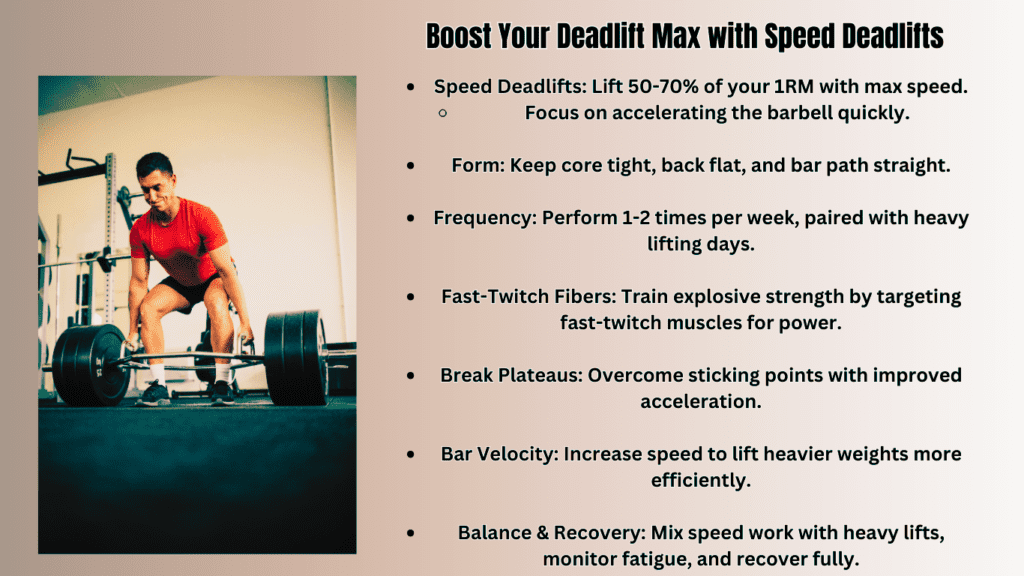
Key Tip: Track Your Nutrition to Ensure a Calorie Surplus
If your goal is to increase strength and size, tracking your nutrition is crucial to ensure you’re in a calorie surplus. A calorie surplus means you’re consuming more calories than you burn, which provides the extra energy needed for muscle growth and strength gains. Here’s how to manage your calorie intake effectively:
- Calculate Your Caloric Needs: Use a calorie calculator to estimate your daily caloric needs based on your age, sex, weight, activity level, and goals.
- Monitor Your Intake: Keep a food diary or use a nutrition app to track your daily caloric intake and macronutrient distribution. This helps ensure you’re consuming enough protein, carbohydrates, and fats to support muscle growth.
- Adjust as Needed: Regularly review your progress and adjust your calorie intake based on changes in your weight, strength, and overall performance.
By focusing on proper nutrition, including adequate protein, carbohydrates, and hydration, you’ll provide your body with the necessary fuel to increase your deadlift max effectively. Tracking your nutrition ensures that you’re meeting your caloric needs and making progress towards your strength goals. This approach not only supports your lifting performance but also promotes overall health and well-being.
Recovery: The Secret to Consistent Progress
When learning how to increase your deadlift max, one aspect that cannot be overlooked is recovery. It might seem counterintuitive, but rest and recovery are as crucial as your workouts. They are essential for muscle repair, strength gains, and overall performance. This section will delve into the importance of recovery, including practical tips and scientific insights to ensure you make consistent progress towards increasing your deadlift max.
Practical Advice: Emphasizing the Importance of Rest and Recovery
- Sleep (7-9 Hours a Night): Sleep is fundamental for effective recovery. During sleep, your body undergoes crucial repair processes that aid in muscle recovery and growth. Aim for 7-9 hours of quality sleep each night. Here’s why sleep is vital:
- Muscle Repair: Growth hormone levels peak during deep sleep, promoting muscle repair and growth. Without sufficient sleep, your body cannot fully recover from intense lifting sessions.
- Performance: Adequate sleep enhances cognitive function, coordination, and overall performance. Poor sleep can lead to decreased focus and reduced lifting capabilities.
- Active Recovery: Active recovery includes activities that help your body recover from intense workouts without complete rest. These activities keep blood flowing to your muscles, aiding in the removal of metabolic waste products and promoting recovery. Some effective forms of active recovery include:
- Light Cardio: Activities like walking, cycling, or swimming at a low intensity can enhance circulation and support muscle recovery.
- Stretching: Incorporating gentle stretching exercises helps maintain flexibility and reduces muscle tightness.
- Foam Rolling: Using a foam roller can alleviate muscle soreness and improve blood flow to your muscles, facilitating quicker recovery.
- Deload Weeks: Deload weeks are planned periods of reduced training intensity and volume. They are crucial for preventing overtraining and allowing your body to recover fully. During a deload week:
- Reduce Volume: Cut back on the number of sets and reps you perform. For example, if you normally do four sets of deadlifts, reduce it to two or three.
- Lower Intensity: Use lighter weights or alternate with less demanding exercises.
- Focus on Recovery: Use this time to emphasize rest, active recovery, and any necessary rehabilitation or mobility work.
Science Angle: The Physiological Importance of Recovery
- Muscle Repair: After intense lifting sessions, muscle fibers experience microscopic damage. Recovery periods allow these fibers to repair and grow stronger. The process of muscle repair involves the synthesis of new muscle proteins, which is vital for increasing strength and size. Without adequate recovery time, this process is disrupted, potentially leading to stagnation or even regression in your progress.
- Central Nervous System (CNS) Recovery: The CNS is heavily involved in strength training, especially during heavy lifts. Intense lifting sessions place significant stress on the CNS, leading to temporary fatigue and reduced performance. Recovery allows the CNS to recuperate, ensuring that you can perform at your best in subsequent workouts. Signs of CNS fatigue include decreased motivation, poor performance, and prolonged soreness.
- Preventing Overtraining: Overtraining occurs when the volume and intensity of your workouts exceed your body’s ability to recover. It can lead to decreased performance, increased risk of injury, and overall fatigue. Proper recovery strategies, including adequate sleep, active recovery, and deload weeks, help prevent overtraining and ensure sustained progress.

Key Tip: Highlighting the Role of Recovery in Preventing Overtraining and Injuries
Incorporating effective recovery strategies into your training regimen is essential for avoiding overtraining and injuries. Here’s why:
- Prevents Overtraining: By allowing your body to recover fully, you prevent the risk of overtraining syndrome, which can stall progress and lead to physical and mental fatigue.
- Reduces Injury Risk: Adequate rest and recovery reduce the likelihood of injuries by ensuring that muscles, joints, and connective tissues have sufficient time to repair and strengthen.
- Promotes Consistent Progress: Regular recovery periods enable you to maintain high levels of performance and continue making progress towards increasing your deadlift max.
By understanding and applying these recovery principles, you can optimize your training, prevent injuries, and ensure consistent progress. Remember, effective recovery is not a sign of weakness but a critical component of a well-rounded training program. Embrace these recovery strategies to enhance your overall performance and achieve your goal of increasing your deadlift max.
Mental Strategies of How to Increase Your Deadlift Max: Overcoming Plateaus
When exploring how to increase your deadlift max, the mental aspect of training is just as critical as the physical. Mental barriers can often be the key obstacle standing between you and your strength goals. This section will delve into the mental strategies that can help you push past plateaus and lift heavier weights with confidence. From visualization techniques to overcoming mental blocks, understanding and addressing these psychological components can significantly impact your performance.
Practical Advice: Addressing Mental Barriers to Lifting Heavier
- Visualization Techniques: Visualization is a powerful mental strategy that involves creating a mental image of yourself successfully performing your lift. This technique helps build confidence and prepares your mind for the physical demands of lifting heavier weights. Here’s how to effectively use visualization:
- Create a Clear Picture: Spend a few minutes each day visualizing yourself performing your deadlift with perfect form and lifting heavier weights. Imagine every detail, from your grip on the bar to the way your body moves during the lift.
- Incorporate All Senses: Engage all your senses in the visualization process. Hear the sound of the weights clanging, feel the barbell in your hands, and see the bar moving smoothly.
- Practice Regularly: Consistent practice of visualization can enhance neuromuscular activation, improving your lifting technique and mental readiness.
- Breaking Mental Plateaus: Mental plateaus can be just as challenging as physical ones. To break through these barriers, focus on setting small, achievable goals that gradually lead you towards your ultimate lifting targets. Here’s how:
- Set Incremental Goals: Instead of fixating on a significant increase in your deadlift max, set smaller, incremental goals. For example, aim to increase your weight by 5-10 pounds each week or focus on improving your form.
- Celebrate Small Wins: Acknowledge and celebrate your progress, no matter how small. Each successful lift and improvement in technique builds confidence and motivates you to push further.
- Stay Positive: Maintain a positive mindset and view challenges as opportunities to grow. Reframe setbacks as part of the learning process and stay focused on your long-term goals.
Science Angle of How to Increase Your Deadlift Max: The Psychology Behind Performance Anxiety
- Performance Anxiety: Performance anxiety can significantly impact your ability to lift heavier weights. It often stems from fear of failure or doubts about your abilities. Understanding and managing this anxiety is crucial for improving your deadlift max. Here’s how:
- Recognize Triggers: Identify situations or thoughts that trigger anxiety before or during your lift. Awareness of these triggers can help you address them more effectively.
- Develop Coping Strategies: Implement strategies such as deep breathing exercises, mindfulness, or positive self-talk to manage anxiety and stay focused on your lift.
- Building Confidence: Confidence plays a crucial role in lifting heavier weights. When you believe in your ability to perform a lift, you are more likely to succeed. Building confidence involves:
- Setting Realistic Expectations: Set realistic expectations for your performance based on your current abilities and training. Avoid putting unnecessary pressure on yourself to achieve unrealistic goals.
- Positive Self-Talk: Use positive affirmations and self-talk to reinforce your belief in your abilities. Remind yourself of past successes and strengths.
- Mental Rehearsal: Regularly practice mental rehearsal techniques to boost confidence and prepare yourself for the physical demands of the lift.
The Role of Visualization in Neuromuscular Activation
Visualization not only helps with mental preparation but also plays a role in neuromuscular activation. Neuromuscular activation refers to the process of engaging the nervous system to control and coordinate muscle contractions. Here’s how visualization enhances this process:
- Enhanced Neural Pathways: Visualization strengthens neural pathways associated with the lift, improving muscle coordination and control.
- Improved Motor Skills: By mentally rehearsing the lift, you can enhance motor skills and refine technique, leading to better execution during actual lifts.
- Increased Muscle Recruitment: Visualization can increase the recruitment of muscle fibers needed for the lift, contributing to improved strength and performance.
Incorporating visualization into your training routine can significantly impact neuromuscular activation, supporting your efforts to increase your deadlift max.
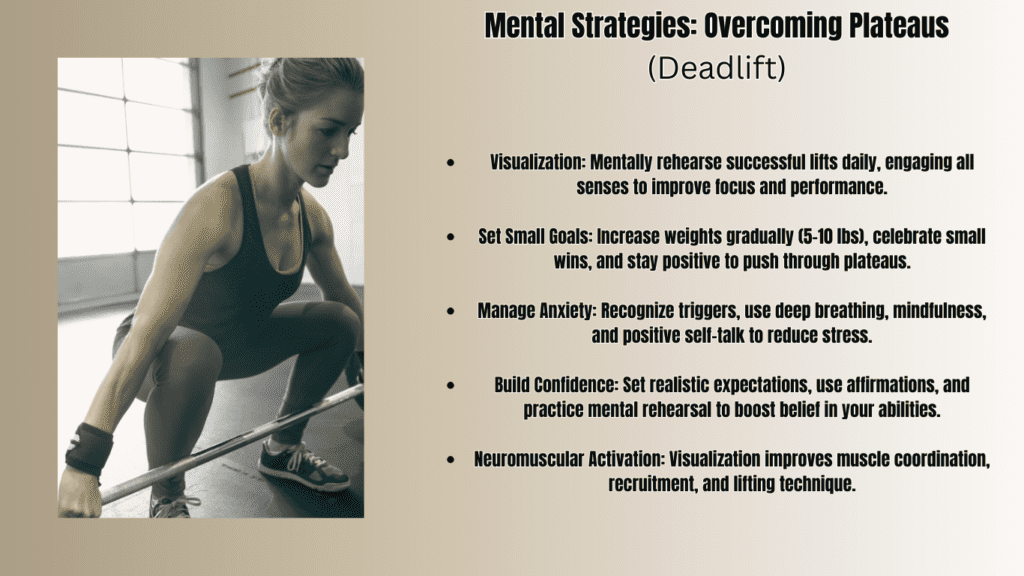
Key Tip: Confidence in the Lift Is Key to Maxing Out
Confidence is a crucial factor in successfully lifting heavier weights. Mental training, including visualization, positive self-talk, and setting achievable goals, is essential for overcoming mental barriers and achieving your deadlift max. By focusing on building mental strength and addressing psychological challenges, you can enhance your performance and make consistent progress towards your lifting goals.
Remember, the journey to increasing your deadlift max involves both physical and mental preparation. Embrace these mental strategies, stay positive, and remain focused on your goals. With the right mindset and approach, you can overcome plateaus, boost your confidence, and achieve your desired lifting results.
Long-Term Focus: Consistency Over Time
When it comes to how to increase your deadlift max, one of the most crucial elements is maintaining a long-term focus. Progress in strength training doesn’t happen overnight; it requires dedication, consistency, and patience. This part will explore why a long-term perspective is essential for achieving your deadlift goals and how to stay on track for sustained progress.
Practical Advice: Progress Takes Time
Increasing your deadlift max is a gradual process that demands consistent effort over time. Here’s how to set yourself up for success:
- Set Realistic Long-Term Goals: It’s essential to establish goals that are challenging yet attainable. Setting unrealistic expectations can lead to frustration and discouragement. Instead, focus on incremental improvements:
- Annual Targets: Aim for gradual increases in your deadlift max over the course of a year. For example, setting a goal to increase your max by 20-30 pounds within a year is more manageable than expecting dramatic improvements in a few months.
- Quarterly Milestones: Break down your long-term goal into smaller, quarterly milestones. This approach helps track progress more effectively and keeps you motivated as you achieve each milestone.
- Adopt a Consistent Training Routine: Consistency is key to making progress. Ensure that your training routine includes regular deadlift sessions and accessory exercises to support your goals. Here’s how to maintain consistency:
- Create a Schedule: Develop a training schedule that fits your lifestyle and stick to it. Consistency in your workouts, including frequency and intensity, helps build the necessary strength and technique.
- Track Your Progress: Keep a training log to record your workouts, weights lifted, and any changes in technique. This helps you stay accountable and make informed adjustments to your program.
- Embrace Patience and Persistence: Understand that significant improvements in your deadlift max will take time. It’s normal to experience periods of slow progress or plateaus. Embrace these phases as part of the journey and stay committed to your training regimen. Patience and persistence are vital for long-term success.
Science Angle: The Concept of Adaptation
- Muscle Adaptation: For muscles to grow stronger and larger, they need to be subjected to consistent, progressive stress. This process is known as adaptation. Here’s how it works:
- Progressive Overload: To increase your deadlift max, you need to progressively increase the stress placed on your muscles. This can be achieved by gradually adding weight, increasing volume, or altering the intensity of your workouts.
- Muscle Growth: As your muscles adapt to the stress, they grow stronger to handle the increased load. This adaptation process involves muscle protein synthesis, where new muscle fibers are created to repair and strengthen existing ones.
- Central Nervous System (CNS) Adaptation: The CNS also plays a crucial role in strength development. Adapting your CNS to handle heavier loads involves:
- Neural Efficiency: Regular training helps improve neural efficiency, allowing your CNS to better coordinate muscle contractions and increase force production.
- Recovery and Adaptation: The CNS requires adequate recovery time to adapt to increased training demands. Consistent training, coupled with proper rest and recovery, ensures that your CNS can effectively handle higher loads over time.
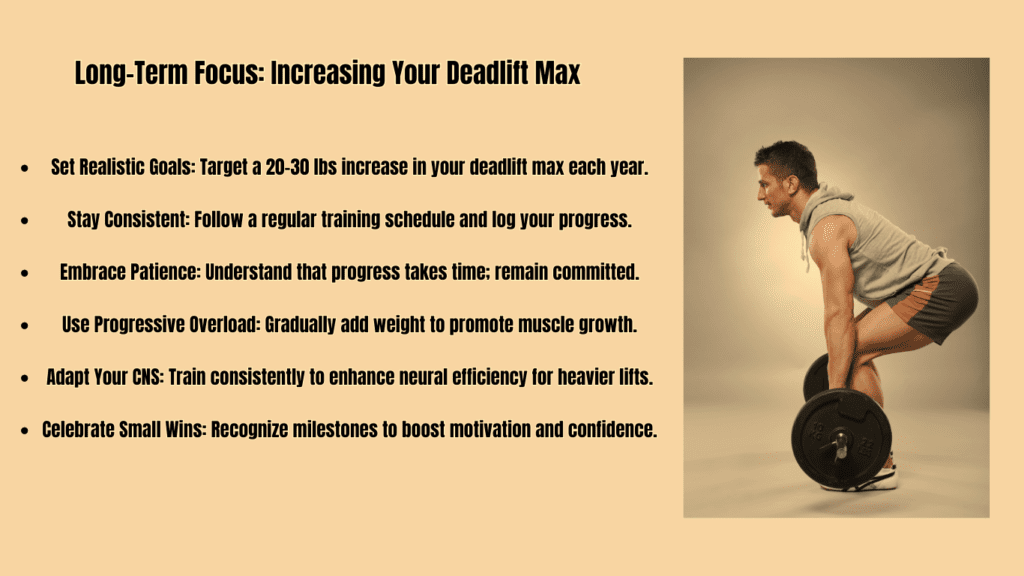
Key Tip: Celebrate Small Wins and Stay Patient for Sustainable Progress
To successfully increase your deadlift max, it’s important to recognize and celebrate small victories along the way. Here’s why celebrating these wins is essential:
- Maintaining Motivation: Achieving small milestones provides a sense of accomplishment and keeps you motivated. Celebrating these wins helps you stay focused on your long-term goals and reinforces your commitment to training.
- Building Confidence: Each small success builds confidence in your ability to reach your ultimate goal. As you experience progress, you’ll gain the self-assurance needed to tackle more challenging lifts and continue pushing your limits.
- Sustainable Progress: By focusing on consistent, incremental improvements, you set yourself up for sustainable progress. This approach reduces the risk of injury, burnout, and frustration, ensuring that you remain on track to achieve your deadlift max goals.
Understanding that progress in increasing your deadlift max takes time is essential for long-term success. By setting realistic goals, maintaining a consistent training routine, and embracing the concept of adaptation, you can ensure steady progress. Remember to celebrate small victories, stay patient, and keep your focus on the long-term journey. With dedication and persistence, you’ll be well on your way to achieving your deadlift max goals.
Common Mistakes to Avoid When Learning How to Increase Your Deadlift Max
When it comes to how to increase your deadlift max, avoiding common mistakes is crucial for both maximizing performance and ensuring safety. While it’s tempting to push hard for quick results, understanding and correcting common errors in your deadlift routine can make a significant difference in your progress and overall health. In this section, we’ll explore some of the frequent pitfalls and how to avoid them to stay on track and achieve your lifting goals.
Practical Advice: Common Mistakes to Avoid When Learning How to Increase Your Deadlift Max
- Ego Lifting: One of the most common mistakes in attempting to increase your deadlift max is ego lifting, or lifting more weight than you can handle with proper form. This often leads to:
- Injury Risk: Lifting excessively heavy weights with poor technique increases the risk of injuries such as herniated discs, strained muscles, or ligament damage.
- Plateaus: Relying on ego lifting can result in stagnated progress as you may not be effectively targeting the muscles needed for growth and strength.
- Prioritize Form Over Weight: Focus on perfecting your deadlift form with lighter weights before gradually increasing the load.
- Use Proper Progression: Follow a structured progression plan that allows you to build strength safely without overloading your muscles and joints.
- Neglecting Mobility: Mobility issues can severely impact your deadlift performance and increase the likelihood of injury. Common mobility problems include:
- Limited Hip and Ankle Flexibility: These limitations can restrict your range of motion and compromise your form during the lift.
- Tight Hamstrings and Lower Back: Tightness in these areas can lead to improper lifting mechanics and added strain on your spine.
- Incorporate Mobility Work: Dedicate time to stretching and foam rolling exercises that target key areas such as hips, hamstrings, and lower back.
- Perform Dynamic Warm-Ups: Engage in dynamic warm-ups that improve joint mobility and muscle activation before your deadlift session.
- Skipping Warm-Ups: Failing to warm up properly is another mistake that can hinder your performance and increase the risk of injury. A proper warm-up prepares your muscles and nervous system for the demands of heavy lifting. Issues with skipping warm-ups include:
- Reduced Performance: Without a proper warm-up, your muscles may not be fully prepared for the intensity of the lift, leading to suboptimal performance.
- Increased Injury Risk: Cold muscles and joints are more susceptible to strains, sprains, and other injuries.
- Include General Warm-Up: Start with a general warm-up such as light cardio to increase your heart rate and blood flow to your muscles.
- Specific Warm-Up: Follow with specific warm-up sets using lighter weights to simulate the movement and prepare your muscles for heavier loads.
- Ignoring Accessory Exercises: Accessory exercises are essential for targeting weaknesses and supporting your deadlift progress. Neglecting these exercises can lead to imbalances and hinder your overall strength gains. Common mistakes include:
- Underdeveloped Supporting Muscles: Failing to strengthen muscles that support the deadlift, such as the glutes, hamstrings, and lower back, can limit your ability to lift heavier weights.
- Imbalanced Strength Development: Focusing solely on the deadlift without addressing muscle imbalances can result in uneven strength development and increased injury risk.
- Integrate a Balanced Routine: Incorporate exercises like Romanian deadlifts, barbell rows, and glute bridges into your training routine to address weak points and support your deadlift.
- Focus on Weak Areas: Identify and work on areas that need improvement to enhance your overall lifting performance and prevent injury.
Science Angle: Risks of Improper Lifting
- Spinal Injuries: Improper lifting technique, such as rounding the back or lifting with a jerking motion, can lead to serious spinal injuries. These include:
- Herniated Discs: Excessive pressure on the spine can cause discs to bulge or herniate, resulting in significant pain and potential long-term issues.
- Spinal Strain: Poor form can strain the muscles and ligaments around the spine, leading to discomfort and reduced mobility.
- Adhere to Proper Form: Ensure that you maintain a neutral spine, engage your core, and use controlled movements throughout the lift.
- Avoid Overloading: Incrementally increase the weight you lift to allow your body to adapt and strengthen gradually.
- Muscular Imbalances: Focusing exclusively on the deadlift without addressing accessory muscles can create muscular imbalances. These imbalances can lead to:
- Increased Injury Risk: Weak supporting muscles may not adequately stabilize the spine and other joints during heavy lifting, increasing the risk of injury.
- Reduced Performance: Imbalances can affect your ability to generate force and perform the deadlift efficiently, limiting your strength gains.
- Incorporate Accessory Work: Perform exercises that target muscle groups not directly worked during the deadlift, such as the glutes, hamstrings, and upper back.
- Monitor Symmetry: Pay attention to any strength or flexibility discrepancies between sides of the body and work to correct them.

Key Tip: Train Smart to Avoid Setbacks
The key to successfully increasing your deadlift max is to train smart by avoiding common mistakes and prioritizing safety. Focus on proper form, incorporate mobility work, and include accessory exercises to address weaknesses and imbalances. By approaching your training with a mindful strategy, you can enhance your performance, prevent injuries, and make steady progress toward your lifting goals. Remember, training intelligently is essential for achieving long-term success in increasing your deadlift max.
Final Thoughts on How to Increase Your Deadlift Max: A Path to Success
As we reach the conclusion of our guide on how to increase your deadlift max, it’s essential to distill the key strategies and emphasize the journey you’re embarking on. Increasing your deadlift max is not merely about lifting heavier weights; it’s about transforming your approach to training, fueling your body correctly, and respecting the importance of recovery. By integrating the insights and techniques we’ve discussed, you can make substantial and steady progress in your strength journey.
How to Increase Your Deadlift Max: Form as the Foundation
The cornerstone of how to increase your deadlift max is mastering your form. Proper technique is critical, not only for lifting heavier but for doing so safely. Focus on achieving the right stance, grip, and body alignment. This isn’t just about aesthetics; it’s about ensuring that every lift is effective and minimizes the risk of injury. Good form helps in transferring maximum force efficiently and supports the correct activation of your muscles, which is pivotal as you strive to increase your deadlift max.
Progressive Overload for Continued Growth
One of the most effective strategies in how to increase your deadlift max is progressive overload. This principle involves gradually increasing the weight you lift to continually challenge your muscles and nervous system. By consistently pushing your limits—whether through small weight increments, varied rep ranges, or different lifting techniques—you stimulate muscle growth and strength adaptation. Remember, the key is to increase stress incrementally to allow your body to adapt and grow stronger without risking injury.
Building Accessory Strength
In addition to focusing on the main lift, don’t overlook the importance of accessory exercises. These exercises are designed to target weak points and support overall strength development. By strengthening supporting muscle groups, such as the hamstrings, glutes, and back, you build a more robust foundation for your deadlifts. Accessory work helps correct imbalances and enhances your ability to lift heavier over time, making it a crucial part of how to increase your deadlift max.
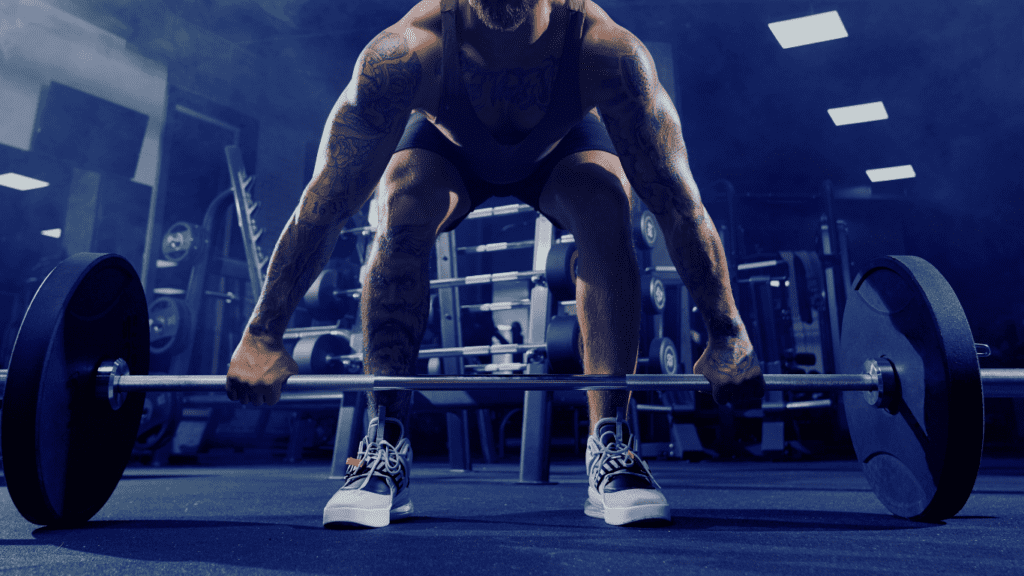
Fueling Your Body
Proper nutrition and hydration are indispensable elements of how to increase your deadlift max. Eating for strength involves ensuring you get enough protein to repair and grow muscles, carbohydrates to fuel your workouts, and staying hydrated for optimal performance. A well-rounded diet supports not only muscle recovery but also overall energy levels and lifting efficiency. Tracking your nutritional intake and adjusting as needed can help you stay on course toward your deadlift goals.
Prioritizing Recovery
Finally, never underestimate the importance of recovery. Muscles grow and repair during rest periods, not during the actual lift. Ensuring you get adequate sleep, incorporate active recovery, and schedule deload weeks helps your body recover from the stresses of lifting and prevents overtraining. Recovery isn’t just about taking it easy; it’s a vital component of a successful strength training program and is crucial for sustainable progress in how to increase your deadlift max.
Stay Motivated and Share Your Progress
Achieving a new deadlift max is a milestone worth celebrating, but it’s also a part of a continuous journey. Stay motivated by setting realistic, incremental goals and tracking your progress along the way. Share your successes and challenges with others in the fitness community to stay inspired and receive support. Remember, each step forward is a testament to your dedication and effort.
In closing, how to increase your deadlift max requires a comprehensive approach. By focusing on perfect form, applying progressive overload, integrating accessory exercises, fueling your body properly, and prioritizing recovery, you position yourself for steady improvement. Embrace the process with patience and persistence, and you’ll find that your efforts will yield substantial gains. Keep pushing, stay committed, and celebrate every victory—big or small—on your path to lifting success.


